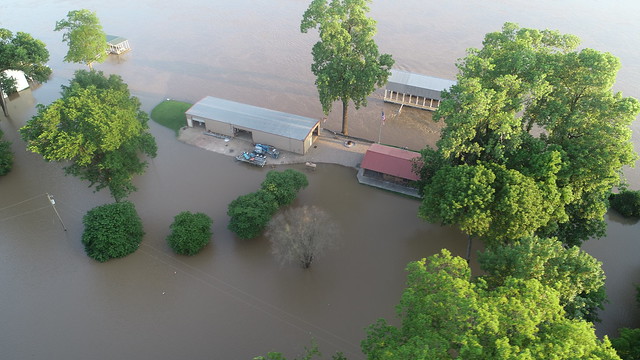Controlling weeds a challenge during a ‘crazy’ growing season
By David Bennett
The U of A System Division of Agriculture
June 2, 2019
Fast facts:
- Weed control concerns grow as weather and planting problems mount
- Rain amounts vary wildly across Arkansas cropland
- Re-planting decisions have producers looking hard at commodity prices
(701 words)
(Newsrooms: With additional art at https://flic.kr/s/aHsmDKidYd and https://flic.kr/s/aHsmDVrFNm )
(Download this story in MS Word format here.)
MARIANNA, Ark. -- A late planting season and a spring of wild weather has Arkansas cropland under multiple threats. Among the biggest concerns is the inevitable arrival of problem weeds and how best to control them as the summer progresses.
“In terms of weed control, it’s always tough when we get a late start to the season,” said Tom Barber, extension weed scientist for the University of Arkansas System Division of Agriculture. “And the later it gets, the more weeds complicate things. For example, this season, we’ve had a lot more nightmare weed issues in corn because the planting window was pushed back.
“Once we get into May and June, especially with the temperatures and amount of moisture we’ve seen, it becomes more difficult to keep the weeds out with residual herbicides,” he said. “Eventually, the rain will flush them out. That usually leads to more applications, regardless of the crop.”
Weed jungles
Time is of the essence, according to Barber, “and most producers have focused on planting on days available to work, but we still need to start clean. Lately, too many are planting into jungles and hoping to clean the field up later. As we’ve learned, it’s a lot easier to clean up before we plant than to clean up after, especially with the levels of resistant weeds we have in the state.”
Another thing to consider: don’t try to plant ahead of the sprayers’ capability.
“If we plant late without getting a pre-emergent or residual herbicide out and then the field gets hit with Palmer amaranth or barnyardgrass, or whatever, there aren’t a lot of post options,” said Tommy Butts, extension weed scientist for the Division of Agriculture. “Do your best to get the sprayer across at the same time you’re planting, and be prepared to flush water after the application to get activation.
“Working in stages – plant, spray, flush, repeat with next field – will provide better weed control and higher yield potential in those fields, but it runs the risk of not getting everything planted,” Butts said. “Planting as much as we can as fast (as possible) will get more crops across our acres, but could lead to more difficulty controlling weeds throughout the season.”
For the most part, it’s been one of the “craziest starts” Barber has ever seen, he said.
“There are areas that have received almost no rain lately, to areas that have received 5 inches. There’s very little between those two extremes,” he said. “There haven’t been many ‘happy scenarios’ where we get a crop planted, spray our residuals and then get a half-inch to an inch of rain.”
At the Jackson County Extension Center, “we’ve had one day to work each week since March – one day a week, that’s it,” Barber said. At the Lon Mann Cotton Station in Marianna, “we’re trying to plant cotton today and we’re digging for moisture. It’s been a strange year.”
All of that makes it difficult from a management standpoint. “We’ve had more acres replanted in corn, cotton and rice than we’ve had in a long time,” said Barber.
“With all the replant situations, there are questions about pre-herbicides and what’s left following these heavy rains, and can the crop selection be changed based on previous herbicides used,” he said. “That’s what I’ve been dealing with for the last couple of months – just helping producers with those decisions.”
Butts cautioned that growers need to stay ahead of the weeds as the season progressed.
“Palmer is the big deal in the corn and soybean crops,” he said. “Barnyardgrass will be the problem in rice. We’re already seeing a lot more sedge populations in rice fields.
“To put it gently, it’s going to be an ‘interesting’ season for growers,” he said. “Do you take preventative plant? Do you stick with corn or rice or soybeans? It’s a tough decision-making process for growers.”
With the Arkansas River flooding, many producers will suffer severely.
“There will be a lot more acres replanted once the waters recede,” Barber said. “For many growers it’s a dire situation. This has been, and will continue to be, a very difficult year.”
For more information about weed control, contact your county extension office or visit www.uaex.uada.edu.
About the Division of Agriculture
The University of Arkansas System Division of Agriculture’s mission is to strengthen agriculture, communities, and families by connecting trusted research to the adoption of best practices. Through the Agricultural Experiment Station and the Cooperative Extension Service, the Division of Agriculture conducts research and extension work within the nation’s historic land grant education system.
The Division of Agriculture is one of 20 entities within the University of Arkansas System. It has offices in all 75 counties in Arkansas and faculty on five system campuses.
Pursuant to 7 CFR § 15.3, the University of Arkansas System Division of Agriculture offers all its Extension and Research programs and services (including employment) without regard to race, color, sex, national origin, religion, age, disability, marital or veteran status, genetic information, sexual preference, pregnancy or any other legally protected status, and is an equal opportunity institution.
# # #
Media Contact: Mary Hightower
Dir. of Communication Services
U of A System Division of Agriculture
Cooperative Extension Service
(501) 671-2126
mhightower@uada.edu
